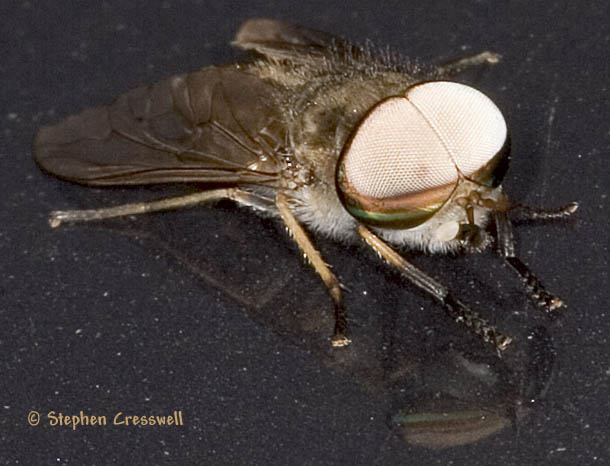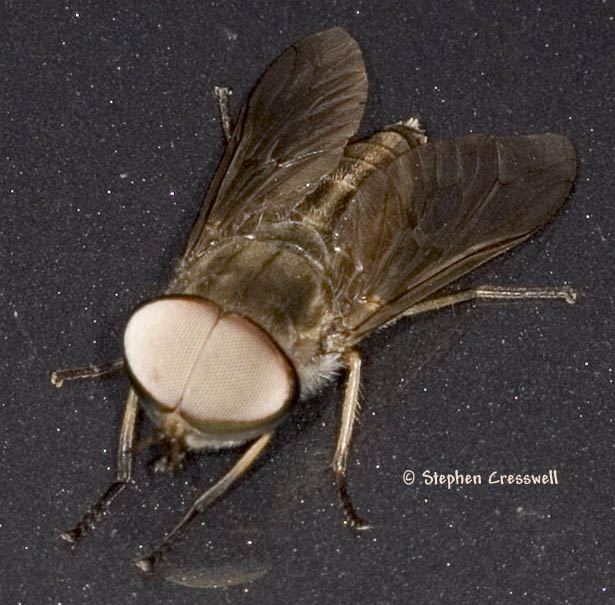Diptera.info :: Identification queries :: Diptera (adults)
|
White-Eyed Horse Fly
|
|
| Stephen |
Posted on 31-07-2006 18:25
|
|
Member Location: West Virginia USA Posts: 1322 Joined: 12.04.05 |
I found this interesting white-eyed fly on my Honda. I got a few photos but he got insulted and left when I tried to convince him to get on a large piece of bark for a more natural background. Open area near woodland, West Virginia USA, 29 July 2006. Didn't record the size, but not at the largest end of Tabanidae. Stephen attached the following image:  [69.89Kb] --Stephen Stephen Cresswell www.americaninsects.net |
| Stephen |
Posted on 31-07-2006 18:27
|
|
Member Location: West Virginia USA Posts: 1322 Joined: 12.04.05 |
Second Photo
Stephen attached the following image:  [92.68Kb] --Stephen Stephen Cresswell www.americaninsects.net |
| Susan R Walter |
Posted on 31-07-2006 19:05
|
|
Member Location: Touraine du Sud, central France Posts: 1802 Joined: 14.01.06 |
Stephen, Stephen - you see where you went wrong? As far as he is concerned your Honda is his natural habitat - especially if the engine was running and it was nice and warm. And he was just sitting there waiting for his female friend, who's natural habitat is the back of your leg, just above the top of your sock, when you are distracted by taking a photo of him on the car. I note that Stubbs says grey cars are found to be the most attractive to horseflies. Really interesting looking fly, but no idea about species I'm afraid. Does it have a few hairs on the eyes showing in the top photo do you think? Susan |
| Stephen |
Posted on 31-07-2006 19:23
|
|
Member Location: West Virginia USA Posts: 1322 Joined: 12.04.05 |
Yes, yes, you're quite right about my mistake. No telling what other wonderful lateral and ventral shots I could have gotten had I not insulted him. All from my odd ideas about natural habitat. Yesterday I saw a beautiful rove beetle, and its habitat was a pile of very wet deer droppings. Should I photograph it in situ? Well that is what I did, but I know no book or magazine will ever run that picture with its particular background. (What magazine would run the picture even with a different background? Rove Beetle Monthly?) I am adding just one more view of the eyes, this one is at full size so no more detail is possible... Stephen attached the following image:  [50.1Kb] Edited by Stephen on 31-07-2006 19:31 --Stephen Stephen Cresswell www.americaninsects.net |
| crex |
Posted on 31-07-2006 20:22
|
|
Member Location: Sweden Posts: 1996 Joined: 22.05.06 |
I see there a a few Tabanus sp that has whitish eyes, for example T. nigrovittatus, T. lineola and T. conterminus. Perhaps you have a checklist of WV Tabanidae ... Nota bene. I no nothing about Tabanidae ...  |
|
|
|
| conopid |
Posted on 31-07-2006 21:52
|
|
Member Location: United Kingdom Posts: 1039 Joined: 02.07.04 |
well, this is just to say he is a fantastic looking fly! Nothing like this in the UK
Nigel Jones, Shrewsbury, United Kingdom |
|
|
|
| Stephen |
Posted on 01-08-2006 10:17
|
|
Member Location: West Virginia USA Posts: 1322 Joined: 12.04.05 |
Thanks, Susan, Nigel, Crex! Sounds like Tabanus is the likely genus. I did a Google "image search" and what is funny about the three species you mentioned, Crex, is that most of them had dark eyes, but a few individuals seemed to have the mostly-white eyes. Not sure why this variation (but then humans have brown, blue, or green eyes!) --Stephen Stephen Cresswell www.americaninsects.net |
| crex |
Posted on 01-08-2006 10:24
|
|
Member Location: Sweden Posts: 1996 Joined: 22.05.06 |
Stephen wrote: ... about the three species you mentioned, Crex, is that most of them had dark eyes, but a few individuals seemed to have the mostly-white eyes ... Yes, I realized that when I googled for more images, sorry. I guess there can be more species with albinistic? eyes ... |
|
|
|
| Tony Irwin |
Posted on 01-08-2006 15:21
|
|
Member Location: Norwich, England Posts: 7318 Joined: 19.11.04 |
I think it's likely that these "white" eyes are found in the males only. You'll notice that the facets are much bigger than in the coloured part of the eyes below. Many male tabanids have larger facets in the upper part of the eyes, and I suspect that when the facets get really big, they tend to look white. Females have more evenly-sized facets, and the eyes tend to be unicolorous (apart from the spots or bands, of course). Not sure why males have these enlarged facets - presumably to help them find a mate, but how it is an advantage to have less visual accuity, I don't know. Tony ---------- Tony Irwin |
|
|
|
| Zeegers |
Posted on 01-08-2006 20:09
|
|
Member Location: Soest, NL Posts: 19208 Joined: 21.07.04 |
Tony is right. Moreover, I think you used a flash, which enhanched the effect. The larger facets are not only larger, but their lenses have a longer focal distance as well. In plain English, they work as small telescopes. The male horsefly sees the world enlarged, though grainy (because there are fewer facets there are fewer 'pixels' projected). Males with large enhanched facets, as far as I know of, are 'sitters': they sit and wait all day on a leave on the lookout. Species with more active males (like hovering) tends to have smaller facets. Theo Zeegers |
|
|
|
| Stephen |
Posted on 02-08-2006 13:04
|
|
Member Location: West Virginia USA Posts: 1322 Joined: 12.04.05 |
I enjoyed this interesting discussion on white eyes in Horseflies. The picture was a flash picture, and unfortunately I did not take a natural light picture for comparison. But I do recall as I first saw the fly thinking, "I've never seen anything like that before, look at the white eyes!" --Stephen Stephen Cresswell www.americaninsects.net |
| Zeegers |
Posted on 02-08-2006 20:37
|
|
Member Location: Soest, NL Posts: 19208 Joined: 21.07.04 |
Point taken. The colours of eyes of (most) Tabanidae is caused by reflection of light at the lense. This is different from most other flies, in which the colour is caused by the inner side of the facets. Its own colour, so to say. And since reflection is dependent on wavelength of the light, different light sources may cause different effects ! Therefore, always keep track, please, if horseflies are flashed, of not. Theo |
|
|
|
| Jump to Forum: |













